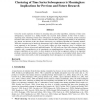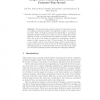70 search results - page 7 / 14 » A simple method of forecasting based on fuzzy time series |
BMCBI
2006
13 years 7 months ago
2006
Background: Diverse modeling approaches viz. neural networks and multiple regression have been followed to date for disease prediction in plant populations. However, due to their ...
KDD
1998
ACM
13 years 12 months ago
1998
ACM
We consider the problem of nding rules relating patterns in a time series to other patterns in that series, or patterns in one series to patterns in another series. A simple examp...
ICDM
2003
IEEE
2003
IEEE
Clustering of Time Series Subsequences is Meaningless: Implications for Previous and Future Research
14 years 29 days ago
Given the recent explosion of interest in streaming data and online algorithms, clustering of time series subsequences, extracted via a sliding window, has received much attention...
DKE
2007
13 years 7 months ago
2007
The challenge in a database of evolving time series is to provide efficient algorithms and access methods for query processing, taking into consideration the fact that the databas...
PAKDD
2007
ACM
14 years 1 months ago
2007
ACM
This work presents a kernel method for clustering the nodes of a weighted, undirected, graph. The algorithm is based on a two-step procedure. First, the sigmoid commute-time kernel...


